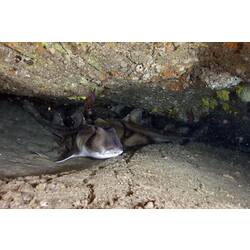General Description
Stocky head and trunk, with small underslung mouth, prominent bony ridge above each eye and a stout spine at the front of each dorsal fin. Pale grey to brown with broad dark irregular lines. Usually females reach about 95 cm, and males 75 cm head to tail tip (up to 165 cm).
Biology
This harmless shark has sharp grasping teeth at the front of the jaws and crushing molars at the rear for feeding on hard shelled prey. Port Jackson sharks aggregate to breed in late winter to spring and, like all sharks, have internal fertilisation. They are oviparous, or egg-laying, with females laying up to 16 leathery, distinctively corkscrew-shaped spiral egg cases in rock crevices and fissures on inshore reefs. Beach-combers often find these dark brown egg cases washed up on beaches after storms. After developing inside the egg case for about a year, juvenile Port Jackson Sharks hatch at about 25 cm in length. Although not used as a food fish, Port Jackson Sharks are caught as bycatch in southern prawn trawl and southern shark gillnet fisheries.
Distribution
Southern Australia.
Habitat
Usually on rocky reefs, but also found on other bottoms, including muddy or sandy bottoms with seagrass beds to depths of 275 m.
More Information
-
Animal Type
-
Animal SubType
-
Fast Fact
Heterodontus is from the Latin meaning many teeth, and the species is named for the locality where the holotype was collected.
-
Brief Id
Head large, low ridge over each eye, two triangular dorsal fins each with a strong spine; pale greyish to brown, with dark harness-like markings.
-
Habitats
-
Diet
Carnivore
-
Diet Categories
Fish, Invertebrates
-
Hazards
Port Jackson Sharks have rough skin covered with large denticles. Although considered harmless to humans, the pointed teeth at the front of the jaws can give a painful bite. The dorsal-fin spines are reportedly venomous.
-
Endemicity
-
Commercial
No
-
Conservation Statuses
CITES: Not listed, FFG Threatened List: Not listed, DSE Advisory List: Not listed, IUCN Red List: Least Concern
-
Depths
Deep ( > 30 m)
-
Water Column Locations
On or near seafloor
-
Taxon Name
-
Scientific Author
(Meyer, 1793)
-
Common Name
Port Jackson Shark
-
Other Names
Bullhead , Bullhead Shark , Dogshark , Horn Shark , Oyster Crusher , Oyster-crusher , Pigfish , Tabbigaw
-
Kingdom
-
Phylum
-
Subphylum
-
Superclass
-
Class
-
Subclass
-
Order
-
Family
-
Genus
-
Species Name
portusjacksoni










